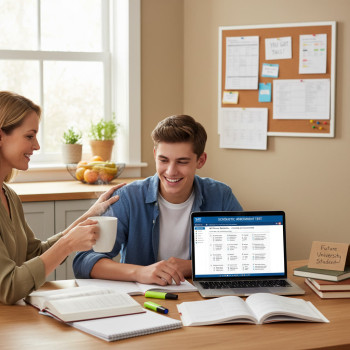Why SAT vocabulary still matters — and why spaced repetition helps
If you’re prepping for the Digital SAT, you might have heard mixed messages about memorizing vocabulary. The test isn’t about knowing obscure words for their own sake — but a strong vocabulary is the quiet engine behind faster reading, clearer writing, and sharper critical thinking. In short: good word knowledge makes the whole test feel easier.
Enter spaced repetition software (SRS). Instead of cramming a list of definitions the night before, SRS helps you learn gradually and sustainably. It’s a study approach backed by the science of memory: you review words right before you’re likely to forget them. Over time, the intervals between reviews get longer, and retention becomes astonishingly good. For busy students juggling classes, extracurriculars, and social life, that efficiency is everything.
What spaced repetition software actually does
At its core, SRS turns flashcards into a smart study system. Every time you see a card, you rate how well you remember it. The software uses that rating to schedule the next review. If you nailed it, the card will reappear weeks or months later. If you struggled, you’ll see it again soon. The result: effort concentrated where it matters.
Key features to look for in an SRS
- Customizable review intervals — so the system adapts to your pace.
- Support for multimedia — example sentences, audio pronunciations, and images help anchor meaning.
- Easy card creation and bulk import — to build or import SAT-focused decks fast.
- Progress tracking — so you can measure improvement and stay motivated.
- Mobile sync — to turn downtime into productive review minutes.
How to build SAT vocab cards that actually stick
Not all flashcards are created equal. A poorly made card can make you feel like you’ve learned something when you really haven’t. Here’s a method for cards that produce durable knowledge.
1. Keep cards simple but meaningful
One fact per card. Put the target word on the front and the definition on the back. But don’t stop there — a bare definition is fragile. Add context.
- Short, natural example sentence that shows typical usage.
- A synonym or two (but avoid perfect synonyms; aim for nuance).
- For tricky words, include a small mnemonic or image idea.
2. Use example sentences from real reading
The SAT rewards context-aware comprehension. If your flashcards show words in sentences that resemble academic or contemporary writing, you’re training the right skill. When possible, copy or adapt sentences from articles you read — journalism, essays, or book excerpts.
3. Include collocations and common pairings
Some vocabulary questions hinge on how words combine with others (e.g., “cast aspersions,” “run afoul,” “bear fruit”). Add a small bullet under the definition listing common collocations to make your knowledge applicative, not just definitional.
4. Use images and audio selectively
Concrete words benefit from images. Abstract words gain from short video or audio examples of usage. Media anchors meaning in a different sensory channel, which strengthens recall.
Designing an SRS study schedule for the Digital SAT
Your study plan should match the test date, current skill level, and other obligations. Below is a flexible framework you can adapt whether you have two months or six weeks.
A realistic weekly rhythm
- Daily review (10–25 minutes): Make review a short, consistent habit. Even five minutes on a busy day is better than none.
- New cards (15–30 minutes, 3–5 times/week): Add a small batch of new words regularly — 8–15 new words per session is reasonable.
- Active practice (1–2 times/week): Use words in free writing, sentence creation, or practice test passages.
- Progress check (weekly): Look at the SRS statistics and adjust how many new cards you add or how you revise tough ones.
Example 12-week plan
This plan assumes steady preparation, but you can compress it if you’ve got less time. The key: keep reviews frequent and consistent.
| Weeks | Focus | Daily routine | Weekly target |
|---|---|---|---|
| 1–4 | Build foundation | 10–20 min reviews; add 10–15 new cards 3×/week | ~300 new words introduced |
| 5–8 | Consolidation & application | 15–25 min reviews; add 5–10 new cards 2×/week; apply in passages | ~150 new words + application practice |
| 9–12 | Mastery & performance | 15–30 min reviews; no more than 5 new cards/week; timed passage work | Maintenance + targeted weak-word work |
Active recall and how to test beyond flashcards
SRS is powerful, but over-reliance on single-word recognition can leave gaps. Pair SRS with active use.
Techniques to deepen knowledge
- Sentence creation: For each new word, write two sentences — one neutral and one with strong emotion or imagery.
- Teaching: Explain the meaning and use of the word to a friend or study partner for 60 seconds.
- Context hunting: Find the word in at least two different articles or excerpts; note changes in register or tone.
- Timed passages: While doing reading practice, underline unfamiliar words and add them to your SRS deck later.
Common mistakes and how to avoid them
Students often make simple errors when using SRS; fixing these multiplies your return on time invested.
Mistake 1: Adding too many new cards at once
Why it hurts: Overloading creates shallow, short-lived learning. Fix: limit new cards per session and prioritize quality (good example sentences and mnemonics).
Mistake 2: Using single-word, out-of-context definitions
Why it hurts: You’ll recognize the definition but fail to understand usage. Fix: always include context and collocations.
Mistake 3: Ignoring review analytics
Why it hurts: You miss patterns in your mistakes. Fix: check the stats weekly and focus on the 10–20% of cards you consistently forget.
Sample card templates you can copy
These three templates are designed for different word types: concrete, abstract, and tricky nuance words.
| Type | Front | Back |
|---|---|---|
| Concrete | Word: catalyst | Definition: a person or thing that precipitates an event. Example: “Her resignation acted as a catalyst for reform.” Synonym: spark; Collocation: catalyst for change. |
| Abstract | Word: anomaly | Definition: something that deviates from what is standard. Example: “The data point was an anomaly, not a trend.” Tip: Often used in scientific/passive contexts. |
| Nuance | Word: temper | Definition: (v) to moderate; (n) a personality trait. Example (v): “Her generosity is tempered by caution.” Example (n): “He has a quick temper.” Note the different uses. |
Integrating SRS into full SAT study — not just vocab
Vocabulary is a tool, not the whole toolbox. Use SRS in a broader strategy that includes passage practice, grammar, math concepts, and full-length practice tests.
Where SRS shines in a full plan
- Tracking vocabulary encountered in reading sections — add new terms from official practice tests into SRS immediately.
- Drilling grammar rules by turning them into mini-cards (e.g., “Rule: Subject–verb agreement — when collective nouns…”).
- For math, use SRS for formula recall, common problem setups, and vocabulary (e.g., “isosceles,” “asymptote”).
Measuring progress: practical metrics that matter
Instead of counting hours, measure outcomes. Look for these signals of real improvement:
- Speed: Are you reading passages and answering vocab-based questions faster?
- Accuracy on practice passages: Are you making fewer mistakes tied to word meaning?
- Retention rate in SRS: A high long-term retention percentage (e.g., 80%+) suggests durable learning.
- Comfort in context: Can you use target words in sentences without pausing to check the definition?
How to troubleshoot plateauing memory
If your progress stalls, don’t panic. Memory plateaus are normal. Try these adjustments:
Change the input
Revise the example sentences, add multimedia, or switch to shorter/longer cards. Sometimes the card simply isn’t memorable.
Mix in retrieval practice
Take a day away from SRS and do a closed-book writing exercise using recent vocabulary. Active production often reveals gaps SRS recognition does not.
Lower the new-card rate temporarily
Give your brain time to consolidate. Fewer new cards means more successful spaced reviews for existing ones.
Sparkl and your SRS workflow (where it fits naturally)
Personalized tutoring can multiply the value of SRS by adding human insight. For students who benefit from tailored support, Sparkl offers one-on-one guidance, tailored study plans, and expert tutors who can:
- Help you choose the right words to prioritize based on practice-test weaknesses.
- Model sentence uses and real-time corrections when you practice producing sentences.
- Use AI-driven insights to identify patterns in errors and recommend which cards to retire or revise.
Used thoughtfully, Sparkl’s personalized help folds neatly into an SRS plan — the software handles spacing; the tutor helps with nuance, interpretation, and motivation.
Putting it all together: a 30-day jumpstart plan
If the test is a month away, you can still make meaningful gains. This focused 30-day sequence prioritizes the highest-impact habits.
- Days 1–7: Build a core deck of 150–200 high-utility words from recent practice tests and readings. Review daily for 20 minutes.
- Days 8–14: Add collocations and three example sentences per word; start applying words in practice passages twice this week.
- Days 15–21: Cut new cards dramatically. Focus reviews on weak words and do two timed reading sessions, noting vocabulary mistakes.
- Days 22–30: Maintain reviews, simulate two full practice sections under timed conditions, and use Sparkl or a tutor session to resolve persistent issues.
Final tips — small moves, big returns
- Consistency beats marathon sessions. Ten minutes a day for months is worth more than one 4-hour cram.
- Quality over quantity. A well-crafted 500-word deck is better than a sloppy 2,000-word list.
- Use reading as your testing ground. Books, essays, and high-quality journalism are your classroom for seeing vocabulary in action.
- Keep it social. Teaching a friend or explaining a word out loud builds deeper memory and keeps study fun.
Closing: make SRS work for your brain
SRS is not a magic bullet, but it’s one of the most efficient tools in a smart SAT strategy. It respects how memory actually functions and gives you back time for the parts of studying that need human nuance: reading comprehension, argument analysis, and timed performance. If you pair high-quality cards with consistent reviews, application in real reading, and occasional human coaching — whether from a mentor, teacher, or Sparkl’s personalized tutoring — you’ll not only remember words, you’ll use them with confidence on test day and beyond.
Ready to begin?
Start small today: pick 10 words from a recent practice passage, craft strong example sentences, and add them to your SRS. Make the habit enjoyable — a little progress every day builds a vocabulary that lasts.
Good luck — and remember: it’s not how many words you know, but how well you can use the ones you do. Study smart, keep it human, and let spaced repetition carry the heavy lifting.













No Comments
Leave a comment Cancel